We use cookies to ensure that we give you the best experience on our website. If you continue without changing your settings, we will assume that you are happy to receive all cookies on the Business Car website. However, if you would like to, you can change your cookies at any time

The start point for the best source of fleet information |
Final report: Volvo XC60 D4 R-Design long-term test
Date: 06 August 2020 | Author: Simon Harris
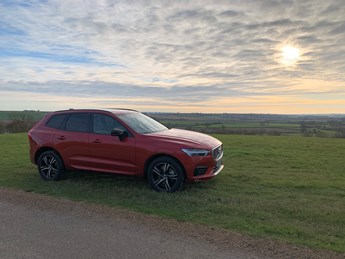
|
|
||||||||||||||||
Final report: Exit of a diesel delight
In the end, my time with the XC60 was rather disjointed. But it didn't affect my appreciation of the car.
We established early on that two-wheel drive is rare in a premium SUV of this size, and before WLTP became the measurement for CO2 emissions it offered a great perk car with much lower CO2 emissions than four-wheel drive rivals.
We also established that someone choosing one post-April would face significantly higher BIK tax payments (although most rival cars would be similarly affected).
Although diesel has been on the wane for the past few years, it still made sense in most cases for company car drivers in larger cars (for BIK tax) and for fleets covering high mileage.
But the landscape is changing rapidly. Many internal combustion engine cars are now being fitted with mild hybrid technology as minor and unobtrusive electric assistance to help reduce emissions.
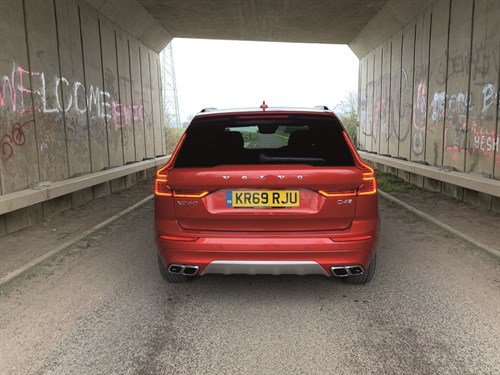
Our Volvo was a standard 190hp 2.0-litre turbo-diesel, although almost a year ago Volvo began to introduce mild hybrid versions to its model line-up.
If you were choosing between the D4 auto and the range-topping 390hp T8 Recharge plug-in hybrid, at the moment, the more powerful car offers BIK tax of around half the amount of the diesel, thanks to CO2 emissions of 56g/km and a BIK tax rate of 14%.
The diesel now falls into the 37% band for BIK tax, so its near £20,000 price advantage over the T8 is nowhere near enough to compete on BIK tax.
But the near £60,000 T8 might well be out of reach for drivers in a D4. However, in the last few weeks Volvo has introduced a lower-power plug-in hybrid: the T6 Recharge. With prices starting at just over £50,000, it might appeal to those who have up to now had to choose a diesel, and they will end up paying significantly less BIK tax.
It will be interesting to track the migration from premium diesel models into plug-in hybrids for those brands that offer the alternative, of course with the usual caveats of fleet operators needing to impress on drivers the benefits of charging a plug-in hybrid frequently.
But maybe as working from home increases, many will find their annual business mileage reduced and plug-in cars make much more sense for them. It certainly doesn't bode well for the future of diesel company cars.
This isn't to say I haven't enjoyed driving the D4. The combination of 190hp and eight-speed automatic gearbox were perfectly suited to my high-mileage driving (pre-lockdown), offering sufficient performance, and regularly achieving in the region of the 42mpg official combined fuel consumption figure.
The Volvo On Call app, as we reported previously, was useful to warm up the car during my early starts in the winter, as well as keep track of basic functions and remaining fuel range remotely.
There haven't been many extended loan test vehicles during my 20-year career in automotive writing that I would have again in a heartbeat after thousands of miles appraising them. Maybe two or three. But the Volvo XC60 is one of them.
Fifth report: An elevated experience
By Illya Verpraet
I was meant to take editor Simon Harris's long-term Volvo for a week, until 'my' Clio (p40) arrived. Then lockdown happened, and now the XC60 has been sitting outside my flat for over two months. Thankfully, giving it a regular run to the shops to
stop the battery from going flat is not exactly a hardship.
Quite the opposite, in fact. For years, Volvo has been working hard to get its cars into the more lucrative luxury corner of the market that's normally occupied by BMW, Mercedes and Audi. While the Swedes had a pretty decent stab at it with their previous generation of cars in the early 2010s, they've really come into their own with this latest generation. The current XC60, like all the current Volvo products, is just a splendid place to spend time.
Driving the latest cars from the Korean, French and Japanese brands, it's easy to start wondering why you'd still need one of these fancy-pants Volvos or BMWs. The 'mainstream' contenders come with as wide a range of engines as you'd like, have all the latest tech, and the days where the interior would be a sea of nasty plastic are long gone.
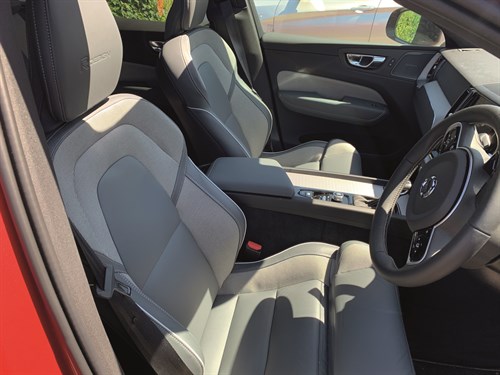
But then you step into something like the XC60 and there are certain touches that just elevate the experience. For instance, Volvo is absolutely on top of its game when it comes to seats. I'm fairly tall, with long legs, and as a result, I struggle to get comfortable in many cars. I have no such problems in the Volvo, as the seats and steering wheel are widely adjustable. Most notably, the extendable seat base on the sports seats that come as part of the R-Design equipment grade means that there's no numbness on a long drive.
I also appreciate the additional creativity in the interior. Just about every vaguely luxurious modern car will come with black leather upholstery. Given the inoffensiveness of black leather and its resulting effect on residual values, one can't begrudge manufacturers or buyers for speccing it, but the combination of the dark leather with a lighter-grey cloth in the XC60 R-Design just lifts the interior ambiance above the dreary blackness of most cars.
Another area where the safety-conscious Volvo scores points is with its adaptive cruise control. Systems that monitor traffic and control your speed accordingly can now be found on everything from a Suzuki Swift to a Mercedes S-Class, but most that I've tried are a bit too jerky for my liking: they have a tendency to accelerate too harshly, and leave it too long to start slowing down, which means they then have to brake suddenly - or worse, beep and flash a warning at the driver telling them to sort it out themselves. It makes it hard to trust them.
The Volvo's, while not perfect, tends to be a lot smoother. The pilot assist function will also take over the steering, and does so surprisingly competently. There are still times, in heavier traffic, when the system needs too much input in order to make smooth progress. Thankfully, however, Volvo makes it easy to switch from adaptive to ordinary cruise control. It seems like a simple and obvious feature to include, but it's one that frustrates in its absence in many other cars.
There is much more to appreciate about the XC60, and, of course, there are some niggles (notably the rather embarrassing, fake, quad exhaust pipes that endow our diesel SUV as part of the R-Design package), but overall, it has plenty going for it to make people desire one, rather than purely need it.
Fourth report: WLTP proves taxing for new cars
The CO2 emissions reading recorded on the V5 document of our Volvo XC60 is 129g/km. Our car was registered late last year, and its CO2 emissions were calculated based on the old NEDC test figure, which uses the CO2MPAS algorithm to reach an intermediate rating.
This was the stepping stone between the old NEDC testing regime and the new worldwide harmonised light vehicle testing procedure (WLTP), the latter coming into force for official fuel economy figures from September 2018 for all newly registered cars.
You will no doubt remember that NEDC - the new European drive cycle - was formulated in the 1990s for official fuel economy tests for all cars sold in Europe.
However, as CO2 emissions were increasingly the target for taxation, manufacturers became more savvy at optimising their cars for the official test in an effort to persuade drivers to choose cars with a lower carbon footprint.
The WLTP was first phased in for fuel consumption and with a graduated stage for CO2 emissions.
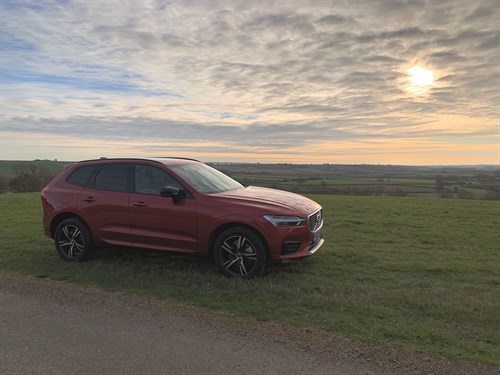
The immediate jump from NEDC to WLTP for CO2 emissions - especially where they were the basis of vehicle taxation - would have been too steep, and punitive for people changing into a similar vehicle.
When we were discussing adding the XC60 to our fleet, Volvo pointed to the 129g/km of the 190hp D4 auto. Two-wheel drive variants are rare in this large premium SUV sector, so the front-wheel drive D4 managed to look more attractive from a tax perspective than four-wheel drive diesel rivals from Audi, Mercedes-Benz and BMW, as well as rear-wheel drive diesel versions of the Jaguar F-Pace. It even had lower CO2 emissions than the Lexus NX 300h, although the 4% supplement on BIK tax for diesel negated its clear advantage over the Lexus.
It also was the only car in its class to fall below the 130g/km threshold, which offers benefits for leasing companies regarding writing down allowances.
Anyone who took delivery of the 129g/km D4 would retain its tax advantages as a driver, but the picture post-April now looks a little different.
Anyone taking delivery of a D4 R-Design for the 2021 model year would see CO2 emissions of 158g/km - 29g/km higher under WLTP than our test car recorded under the NEDC-correlated system, putting it into the maximum 37% band for BIK tax.
Surely it is still better than its rivals though? Well, for CO2 emissions, yes it mostly is. Most of its rivals mentioned earlier record CO2 emissions of higher than 160g/km. However, BMW and Mercedes-Benz have since launched RDE2-compliant diesel engines for their XC60 rivals, as well as making other fuel-saving technology available.
This means someone choosing a BMW X3 2.0d xDrive has the advantage of a mild-hybrid system bringing down CO2 emissions a little, and the RDE2-compliance eliminating the 4% supplement on its BIK tax.
The M Sport might be priced £3,000 higher than the XC60 D4 R-Design, and have CO2 emissions of 157g/km, but the absence of the diesel supplement puts it into the 34% tax bracket and offers slightly cheaper monthly BIK than the XC60.
The Mercedes-benz GLC 220d AMG Line has CO2 emissions of 165g/km, but its RDE2-compliant diesel engine puts it in the 36% tax bracket, and comparable pricing gives it a small tax advantage.
We are really enjoying all the ownership aspects of the XC60, including the comfort, performance, safety and style, but if we were making the choice now, the figures no longer stack so comfortably in the Volvo's favour with the absence of RDE2-compliant diesel.
Third report: Artificial intelligence
Many cars are selling now on the basis of their connectivity to the world around them, and to the driver and other occupants.
Cars may be offered with certain online services, such as Google searches, and other internet connectivity, and there has also been an increase in manufacturer- branded apps, downloadable to you smartphone and other devices.
Our Volvo XC60 comes with such capability, much of it contained within the Volvo On Call app. I have mentioned previously how it can be used to monitor the status of the vehicle remotely, send navigation instructions to the car after finding a location within the map, and activate a number of functions.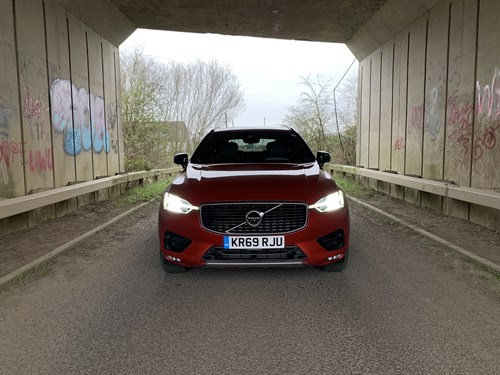
For example, using the Volvo On Call app, you can switch on the lights and combine that with sounding the horn to help you locate the car at night when you're out of range of the key.
When at home, I park the car off-street, and on frosty mornings I can turn on the engine remotely from the app. It will run for up to 15 minutes or can be deactivated again through the app or by unlocking the car and using the start toggle.
On cold days, the heated driver's seat and heated steering wheel are also activated, as well as the defrost function for the windscreen. It means the car can be set to warm a few minutes before I'm ready to leave and is ready to drive away immediately when I am.
If it were a plug-in hybrid version, the climate control could be activated on a timer, or ad hoc using the app, and the car can be warmed or cooled, depending on the conditions, using the plugged-in electricity supply, thus preserving the hybrid battery for zero-emissions running on the road.
As a near three-year old model, the XC60 might be starting to fall behind some premium rivals when it comes to all the technology working together. For example, in a number of more recently launched products from rivals, when a route is set in the navigation, the driver can get a reminder to lift off the accelerator when approaching a roundabout or junction on the route.
Volvo doesn't have this functionality just yet on the XC60, and while I'm not 100% convinced of its value, as the driver should be aware of nearby navigation points that would also be displayed on road signs anyway, it would be more in keeping with the other technology on the car.
However, when the low fuel warning light is on, it will offer to navigate to the nearest filling station, displaying its name so the driver can select or dismiss it and find another should a certain brand be preferred for fuel cards or price reasons.
The car's optional Pilot Assist system remains invaluable on my typical long journeys that run into congestion on motorways. The car can monitor the flow of traffic, maintaining its position in the centre of the lane and keeping a safe distance from the vehicle in front.
The driver remains in control of the functions, but delegating some of the work to the car really does help reduce fatigue.
During the first three months of running the XC60, it has racked up 7,000 miles very comfortably, so it won't be too long before Volvo will be arranging its collection. But in the meantime I'll be enjoying the remaining few weeks that it's with us.
Second report: Business class continental travel
We will soon be completing our third month with the XC60, and so far it has been thoroughly dependable.
We don't necessarily run our test cars in the expectation that something will go wrong, but it is sometimes surprising that at the accelerated pace of life some of us run them at in terms of the mileage we cover, problems are absent.
Last year, when we ran a Volvo V60, it had more than its fair share of hiccups along the way, and most of them were not Volvo's fault.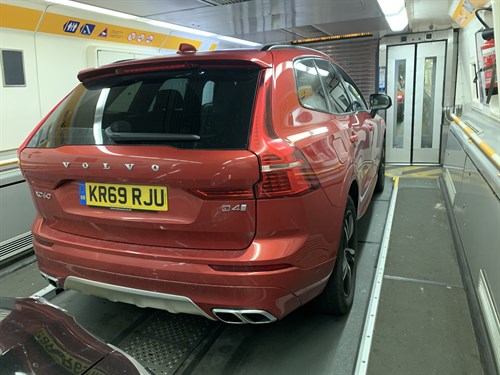
The XC60 has racked up several thousand miles in its first couple of months, including a trip across the channel to the Netherlands.
This type of work is well within the Volvo's comfort zone, and it has all the tools necessary to minimise stress and frustration, whether on the open road or stuck in traffic.
The D4 diesel engine produces sufficient performance to overtake slow vehicles safely, and when it all comes to a stop, the optional Pilot Assist remains vigilant for traffic movement ahead, and keeps the XC60 within its lane and at a safe distance from the vehicle in front.
The exterior styling kit, which is a £1,350 premium over the standard R-Design look, includes metal-look skid plates front and rear, as well as twin exhaust pipe finishers.
It does give the XC60 more off-road purpose in its appearance, although on close inspection the exhaust finishers are clearly separate from the pipe tips.
Better from a distance, perhaps, and questionable as to whether it is worth the money on the accessories.
First report: Hitting the sweet spot
There is satisfaction in hitting a sweet spot. I can imagine Volvo's UK corporate sales team was delighted when the XC60 D4 with front-wheel drive achieved 129g/km of CO2. Currently, emissions below 130g/km are beneficial for business leases, with a greater writing down allowance for tax purposes.
Obscure, perhaps, but in a sector where the majority of products are desirable, small details could make all the difference. The vast majority of the XC60's premium rivals only offer four-wheel drive variants, all of which have higher CO2 emissions.
The Jaguar F-Pace is offered in rear-wheel drive variants, but the CO2 emissions put it several tax bands higher than the XC60.
Of course, there could be a recalibration of the writing down allowance rules as the full WLTP CO2 emissions ratings come into force for cars registered from April 2020, but for now the XC60 D4 auto is sitting pretty.
Even the hybrid Lexus NX can't achieve the CO2 emissions of the Volvo, although it currently falls into a slightly lower BIK tax bracket because the Volvo carries the 4% supplement on diesel company car tax.
The D4 engine produces 190hp and is Volvo's own 2.0-litre unit. It comes
with an eight-speed automatic gearbox, and our R-Design model has steering wheel-mounted paddles to shift through the gears manually, if required.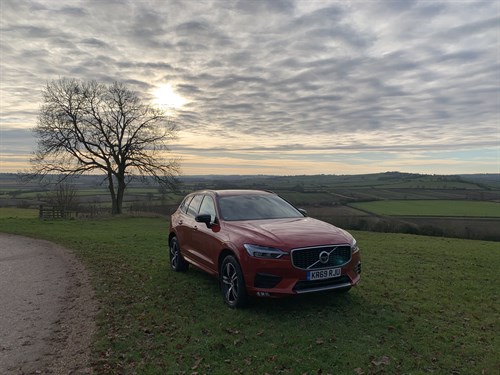
The R-Design is popular with user-choosers, riding on 19in alloy wheels and lowered sports suspension, and with gloss black window surrounds (in place of chrome) and other styling enhancements. However, we added the optional exterior styling pack, which includes unique finishers for the exhaust pipes, as well as scuff plates on the front and rear bumpers.
Inside, the R-Design offers a more modern look, with aluminium trim inserts, plus leather and cloth seat trim.
My previous experience behind the wheel of a Volvo before taking delivery of this XC60 was in the compact XC40. I was surprised at the more relaxed gait of the XC60, in spite of the R-Design upgrades to the chassis, which perhaps highlights how nimble the XC40 feels, as well as Volvo knowing its target audience quite well.
The XC60 is a more fully fledged family car than the XC40, and I have been pleasantly surprised by its ride comfort (for an R-Design on 19in wheels). While it doesn't encourage the driver to hurry on twisty roads, the XC60 also doesn't feel unsafe when driven with a dash of urgency.
Already the Volvo On Call app is making itself useful, as it is possible to start the car remotely and thaw the frost for a couple of minutes before leaving the house. The optional winter pack heats the seats and steering wheel while it is running, so the car is already warming up by the time you open the door.











